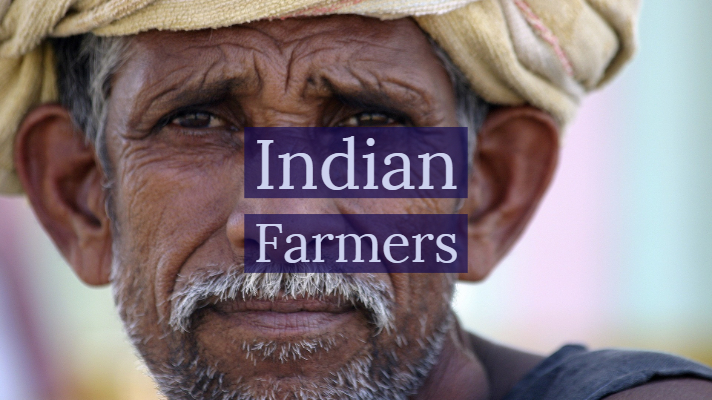We at Clrskills are always looking for opportunities to find the best content on the internet for our audience. Being in to business of providing skill development solutions to the corporate and industries country wide, we have observed a serious shift in people coming to join the industries from the agricultural belt. Although we are quiet aware of the problems that the farmers are facing but still we needed to find some logical content where we could find a blogger like us penning his views on the issue. We found this blog post by Col DS Chahal on the website called olive greens titled “Reasons for the Plight of Indian Farmers and Options to Redress the Challenge” . Just one read and we knew that this content should be on our blog and for for our readers. Although the blog entry is an year old still it is a source of deep knowledge on the issue. We are reproducing the blog post here in original as was written by Colonel Chahal and thank him for putting in such great insights. This blog entry will also further strengthen our resolve to keep on helping the citizens of the country in learning skills which would give them proper employment.
Introduction
The human skull carrying farmers from the state of Tamil Nadu have been agitating at Jantar Mantar, New Delhi for over a month now.
The demands of the farmers include waiver of nationalized bank loans, constitution of Cauvery Management Board and drought relief of Rs 40,000 crore to tide over their immediate distressful situation arising out of third consecutive drought in the region.
Two days ago, people from different walks of life from the State, including farmers, students and general public, launched a blood signature campaign to express solidarity with the farmers.
The dismal state in which the Indian farmers find themselves today may be attributed to the shift of focus of the successive governments from the agriculture sector, since the green revolution of 1960s, to the higher revenue generating and thus more lucrative service and industrial sectors.
Hence, progressively there was a decline in capital formation in the agro sector, the policy makers resorted to inadequate expenditure on irrigation and extension services in rural areas, and a dearth of cheap institutional credit, resulted in a slowdown of agricultural growth and heightened livelihood insecurity for a substantial proportion of those dependent on agriculture.
Distressful Plight of Indian Farmers
It may be noted that 65% of the total workforce in India belongs to the agriculture sector, which contributes about 15% to thecountry’s $2 trillion economy.
The most important reason for the distressful plight of the Indian farmers is that 80% of them are small and marginal farmers, who are dependent for their survival on less than five acres of land. Nearly, 50% of rural households and 36% of the total households in India belong to this category.
India with its diverse land mass is also subjected to diverse furies of nature. It is estimated that 70% of the country’s arable land is prone to drought, 12% to floods, and 8% to cyclones.
The employment of outdated agriculture practices on limited land holdings, which inhibits experimentation for progressive and revolutionary farming, has resulted in agriculture productivity levels to become stagnant over the previous few decades.
NITI Aayog recently highlighted that the agricultural sector in India is 28 years behind its time.
Furthermore, the workforce employed in the farming sector, constitutes of uneducated, unskilled labour, who have not empowered themselves with any other alternative skill set. Hence, they have very restricted options to earn their livelihood.
The world today is discussing its transition from the Millennium Development Goals (MDGs) to Sustainable Development Goals (SDGs), which aim to end poverty and hunger and promote sustainable development. In the prevalent milieu, the small farmers hold the key to success of the said global goals.
Historical Perspective
Farmers in India have been at the receiving end from times immemorial. Historical records relating to frustration, revolts and high mortality rates among farmers in India, particularly cash crop farmers, date back to the 18th and the19th century.
The Izaredari System was introduced by Warren Hasting, the then Governor of East India Company in 1773. Wherein, Izaredars were appointed by the East India Company to collect revenue from the peasants and farmers.
The revenue collectors (Thekedars) who were further deputed by the Izaredars adopted extremely harsh methods to execute their task.
Later, in 1799, Lord Cornwallis introduced the Permanent Settlement System, in which the Zamidars were made the permanent owners and landlords, who could keep 11% of the total produce for themselves and pay the balance 89% to the Company.
The actual cultivators were reduced to tenants and were deprived of all rights over the land that they physically tilled.
Permanent settlement fixed the revenue for 10 years. Irrespective of the vagaries of weather or any calamities, the peasants had to pay up the Landlords, who treated them worst then slaves.
Naxalism is actually an outcome of the harassment faced by the peasants at the hands of their landlords. Their extreme state of deprivation compelled them to take up arms against the landlords.
The Deccan Riots of 1875-1877 were an outcome of high land taxes of 1870s, which were payable in cash, regardless of the effects of frequent famines on farm output or productivity, combined with colonial protection of usury, money lenders and landowner rights.
In the present times, especially in India, the policy of liberalisation and removal of trade barriers between countries have created the farm crisis, for the following reasons:
- A shift from ‘food first to trade first’ and ‘farmer first to corporate first’ has discouraged farmers and restricted growth of Agriculture sector.
- The cost of agricultural production has increased immensely because of high reliance on chemicals, heavy dependence on mechanised farming and the deregulation of the input sector, like, sale of seeds, pesticides, fertilizers and now even diesel.
- Deregulation of markets and lack of effective price regulation of the farm produce, has led to a mockery of poor farmers, who are given ridiculously low prices for their farm commodities.
- The present agriculture policies, at least on the paper, suggest alternatives to boost the agro-sector, e.g. establishment of agro-processing industry and promotion of agri-businesses by way of providing subsidies. However, these subsidies are being enjoyed by already prosperous individuals in the field, like those who own cold storages, transport and allied ancillary services. These subsides do not reach the small/ marginal farmers who actually need them.
Major Reasons for Farmer Suicides
According to the National Crime Records Bureau, as many as 5,650 cases of farmers’ suicide are recorded in India annually. Out of the said figure, more than half are recorded from Maharashtra alone.
The states of Madhya Pradesh, Telangana, Chattisgarh and Karnataka also record large number of farmer suicides. In India, farmer suicides account for 11.2% of the overall suicides committed.
Let us look at the major reasons that push the farmers to take this extreme step:
Non-availability of institutionalised credit facilities and high rates of interests: It is highly cumbersome for a farmer to get institutionalised loan because of the elaborate paperwork requirements and guarantees required to be furnished.
Heavy debts on farmers: Since, the small/ marginal farmers are unable to obtain institutionalised loans, they resort to taking loan from the unorganised sector through moneylenders to meet their domestic and agro related express requirements.
The rates of interest charged by the moneylenders are anything in the range of 24 to 60 percent per annum; depending upon how urgent or inescapable is the need of the farmer.
Invariably, the farmers are unable to pay up such high interest rate and are often seen harassed by the goons of the moneylender. In such extreme cases the farmer is left with no other option but ‘cancel his captivity’.
Inadequacies in implementation of safety nets: Successive governments have been incapable of effectively implementing social welfare schemes appropriately.
Government schemes to safeguard the bare necessities of the underprivileged such as running of fair price shops (FPS), various forms of food for work schemes and correct regulation of public distribution system has been grossly inadequate in the country.
Delayed and ridiculously meagre compensation for the crops damage caused due to natural calamities is never enough for the farmers to pay their debts and also have adequate capital for sowing of the next crop.
Minimum Support Price (MSP) does not support the increased inflation: The farmers, who sell their farm produce to the private buyers (middle men) designated by the Food Corporation of India (FCI) are routinely duped, harassed and paid inadequate compensation.
Many times the private buyers hold the farmers to ransom by threatening them that they will not pick up their perishable items, which are “supposedly” not meeting the quality tests being conducted at times by corrupt officials of FCI.
So, this ‘coterie of thugs’ is able to undervalue the farmer’s produce, mostly even below the official Minimum Support Price announced by the government.
The middle-man in turn sells the produce at the government procurement centres and pick up undeserving profits, which should have rightfully gone to the farmers.
Disproportionate increase in the cost of agriculture inputs: The relative increase in the cost of agriculture inputs like seeds, fertilizers, pesticides, diesel, etc is not commensurate with the annual increase of minimum support price announced by the government.
The reducing scale of crop productivity and diminishing land holdings, coupled with high input costs has progressively declined the profit margins of the farmer. Consequently, their basic sustenance has become a major challenge.
Unpredictable weather conditions: The weather conditions have become extremely erratic and unpredictable owing to climate change.
The cumulative crop losses force the farmers to take loan from multiple unethical sources. This vicious cycle leads them into an abyss of unmanageable debt.
They are then haunted by the moneylenders, their own growing domestic demands and the need for more money to sow next crop.
Reduced land holdings: A successive property division, leading to very small land holdings, has made agriculture unviable as a profession. The small landowners still continue to cultivate low-value conventional crops, which makes their farming unsustainable.
Inappropriate land use and cropping pattern: Large scale cultivation of conventional subsistence crops, like wheat and rice has resulted in creating a surplus, which affects its price negatively.
Since the input cost of conventional crops is high, the yield per acre is more or less stagnant; the profit margin has over the period declined. Besides, this cropping pattern erodes fertility of soil, reduces resistance to diseases and extensive rice cultivation has very adversely affected the underground water table.
Similarly, the input cost of cash crops, like tea and coffee is extremely high as compared to the value of India commodities in the world market, which has made its cultivation unviable. A number of tea gardens in the NE have shutdown or are at the verge of shutting down, rendering a huge selectively skilled workforce jobless.
Remedial Measures
Re-examining the National Policy for Farmers (NPF): The government has recently set up an expert committee to scrutinise the functioning of the NPF (which was established 08 years now), so as to identify and address the specific reasons for farmer’s suicides.
Re-examining the basis of working out MSP: At present the Minimum Support Price (MSP) is decided every year by the ‘Commission on Agricultural Costs and Prices’.
Recently, government has announced that it would re-examine the basis of working out the MSP, so that it allows risk free farming and cuts losses.
Disaster relief: A total of Rs 61,291 crore has been earmarked for 2015-20 to provide relief to the States which may be hit by various natural and manmade disasters.
Introduction of National Agricultural Insurance Schemes: On 13 January 2016, the Cabinet had approved the ‘Prime Minister Crop Insurance Scheme’.
This insurance scheme for farmers provides insurance coverage and financial support to farmers in the event of failure of any of the notified crops as a result of natural calamities, pests and diseases and protects them against crop failures owing to successive droughts.
The farmers are required to pay premiums of as little as 1.5 percent of the value of their crops, allowing them to reclaim their full value in case of natural damage.
However, this scheme has not found much favour with the farmers.
Biodiversity, through crop rotation must be the basis of production to reduce vulnerability to climate and markets.
Encourage farmers to adopt low cost organic farming based on cost-effective technology with most suitable crop patterns and indigenous pest management practices.
Integrated Pest Management (IPM): Farmers need to be sensitised regarding this effort that can be organised at the regional agriculture university level so that the crop of neighbouring farmers, not using pesticides, does not get damaged.
Government/ NGOs with a vision of eco-friendly sustainable development should guide the farmers to make the efficient use of water, electricity, pesticide and other inputs.
Government could provide community implements and machinery at panchayat / block level so that small and marginal farmers can also use mechanised techniques of farming at lesser cost to improve productivity.
Institutionalized Credit System e.g. Jan Dhan Yojana and MUDRA banks must be simplified and farmers be made aware of their rights and governments’ initiatives in this regard.
Moneylenders charging the farmer’s exorbitant rate of interest must be identified and punished for running such a racket.
The role of commission agents, traders and intermediaries should be minimized to facilitate the farmers to fetch maximum price of their produce. Governments’ initiative pertaining to e-Mandi must be effectively implemented on ground.
Strongest punitive action should be taken against suppliers of spurious seeds and manufactures of spurious pesticides.
Gram Panchayats should evolve a mechanism to identify the indebted and suicide prone farmers and help them to overcome the crisis.
Personal Accident Insurance Scheme covers Kisan Credit Card Holders, to provide relief in an eventuality of an accident.
To sustain the family of the deceased, all the financial help should be provided as ‘Fixed Deposit’ in the bank, with quarterly payment of interest.
Recent Government Initiatives
The agriculture ministry in consultation with the Niti Aayog has identified a set of nine marketing reforms to ensure remunerative prices to farmers for their produce by reducing the role of middlemen.
These measures are likely to be in place by July 2017 and are considered to be one of the key steps of the government to live up to its promise of doubling farmers’ income by 2022.
The noteworthy reform measures that have been identified include:
- Integration of market to e-NAM (National Agriculture Market) within the shortest possible time so that the farmers have multiple options to sell their produce at competitive prices without the involvement of any middleman. The proposed NAM framework envisages integration of 585 major regulated mandis across the country for real-time electronic auctioning of the commodities along with integrated assaying, weighing, storage and payment systems.
- In order to encourage agro-forestry, which has a huge potential for supplementing the income from agriculture, farmers will be exempted from felling of trees grown on their private land.
- Relaxing of transit regulations will help movement of timber from one part of the country to the other and reduce dependence on imported timber to meet the huge demand for wood in the country.
- Government is working towards creating a unified market platform where any licensed trader can buy the farmers produce online. The licence will be required to be obtained by the trader from the Director of Agricultural marketing. The advantages of the unified trading licence will be that the trader will be able to purchase the notified commodities in all the notified markets of the state with a single license. The same will save time, bring about quality control through a transparent regulatory mechanism.
- Furthermore, there will be a single-point levy of market fee, so as to simplify the procedures and make trade of commodities less cumbersome.
- The National Agricultural Policy 2000 envisages an active participation of the private sector in agriculture. The same can give a real fillip to the agro-sector by conducting research and introducing improved technologies, provision credit through cooperatives and self-help groups, create infrastructure (for seeds, fertilizers & pesticides), transportation and processing services, warehousing and cold storage facilities to prevent rotting of food grains, help with all other extension services, carry out contract farming, direct marketing and setting up of private markets to allow accelerated technology transfer, capital inflow and create an assured market for crop production.
Conclusion
It is very unfortunate that the nation as a whole has failed to appropriately strengthen the hands that feed us. The farmers live in a state of unprecedented deprivation and most deaths are due to lack of adequate medical facilities or starvation or physical and mental agony.
The government must not adopt a myopic approach to address this very serious challenge by simply doling out relief packages for farmers and waiving off bank loans to tide over immediate problems.
The government needs to look at the holistic picture and adopt policies that are in the long term interest of farmers, e.g. interlinking of rivers for irrigation and mitigating flood disasters, skill development of the workforce, better regulated marketing system and employment of technology and private players to qualitatively boost the output and make the Indian agriculture sector globally competitive.
Credits : http://www.olivegreens.co.in/blog/reasons-for-the-plight-of-indian-farmers-and-options-to-redress-the-challenge
Original Content Credits : Col DS Chahal.






